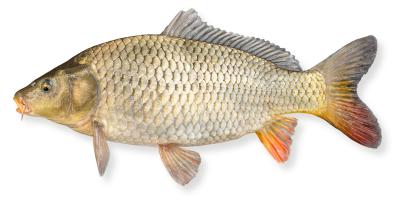Common Carp
Cyprinus carpio
 Distribution: The common carp is native to Eastern Europe. It was domesticated and used as a food source by the Romans and has now been spread throughout the world to every continent except Antarctica. In New Hampshire, the common carp is abundant in the Merrimack and Connecticut Rivers, where it was introduced in the late 1800’s. It is also known to occur in Mascoma Lake.
Distribution: The common carp is native to Eastern Europe. It was domesticated and used as a food source by the Romans and has now been spread throughout the world to every continent except Antarctica. In New Hampshire, the common carp is abundant in the Merrimack and Connecticut Rivers, where it was introduced in the late 1800’s. It is also known to occur in Mascoma Lake.
Description: The common carp is the largest species of minnow in New Hampshire. It may be easily distinguished from other large minnow species by two barbels on either side of its upper jaw. Its scales are very large, tough, and diamond shaped with an olive green to golden bronze color.
Species commonly confused with: White sucker
Habitat: Common carp prefer warm, slow moving water with aquatic vegetation and mud or silt bottom, although they can be found in a variety of habitats.
Life History: Common carp have an extremely varied diet, feeding on everything from algae and plant matter to aquatic invertebrates. They may grow to weigh over 60 pounds. As bottom feeders they can cause considerable turbidity as they suck in and expel bottom sediments, consuming anything edible before it settles to the bottom. Female carp mature by the age of three. Carp are extremely prolific. They are capable of producing between half a million and 2 million eggs, depending on the size of the female. Spawning takes place in spring among aquatic vegetation in shallow water, where a number of males gather around each female. The splashing and churning of carp spawning in shallow water can be conspicuous, especially in larger numbers.
Origin: Introduced
Conservation/Management: Common carp are considered an invasive species that can cause habitat degradation by increasing turbidity. They may also compete with native species for food resources. In New Hampshire, carp have become naturalized in the larger rivers where they have been residents for over a century.



